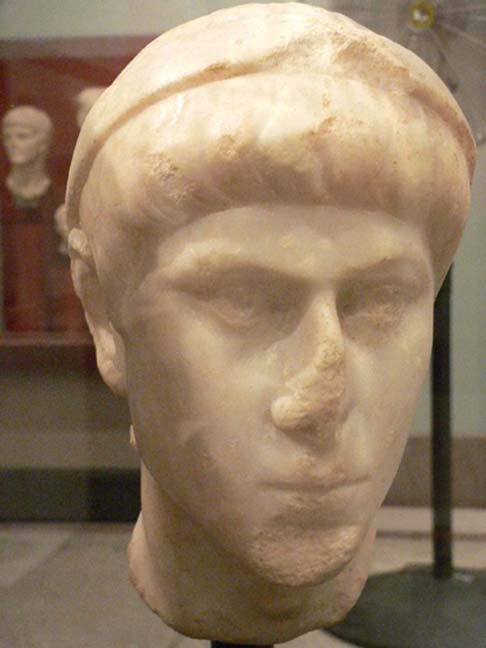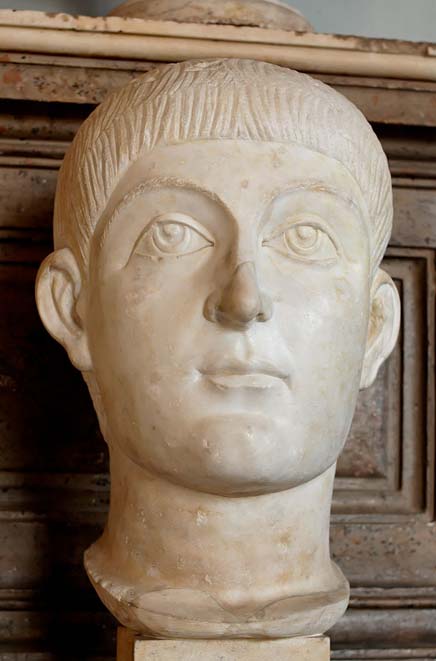
From Papyrus to Parchment: The Imperial Library of Constantinople
Many years after the destruction of the great libraries of the ancient world, such as the libraries of Pergamum and Alexandria, the Imperial Library of Constantinople preserved precious Ancient Greek and Latin texts for almost 1,000 years. Located in the capital city of the Byzantine Empire, the library was constructed circa 357-353 CE by the emperor Constantius II, as he became aware of the deterioration of the early text which had been written on papyrus. In the library’s scriptorium, he entrusted scribes with the arduous process of copying out the volumes from the papyrus rolls to more stable materials such as parchment or vellum. The man in charge of the scribes was thought to have been Themestios, working directly under Constantius II in the supervision of the library.

Bust of Constantius II (CC BY-SA 2.0)
The Emperor Valens, circa 372 CE, continued the efforts of his predecessor, Constantius II, by employing four Greek and three Latin calligraphers. From this, the majority of the Greek classics that we possess today are known through the Byzantine copies originating from the Imperial Library of Constantinople. However, certain tomes were given preference over others. Those working as scribes, copying the texts from papyrus to parchment, dedicated a great deal of time and attention to preserving what they considered to be the worthiest. Older works, like Homer and Hellenistic histories, were given greater priority over later Latin works. Similarly, more notable names, such as Sophocles and his contemporary philosophers, were prioritized over lesser known names.
- Byzantine shipwrecks reveal advanced shipbuilding techniques
- Ancient equivalent of tablet computer found in Turkey dig
- The destruction of the Great Library of Alexandria

A marble bust possibly representing Valens (Public Domain)
It is thought, by some historians, that the Imperial Library might have housed as many as 100,000 manuscript volumes, some of which may have come from the Library of Alexandria; having been preserved after the fire that destroyed it. However, accounts recording the destruction of the Library of Alexandria are contradictory, and the knowledge on the contents of the Imperial Library of Constantinople are scarce. Alexandria is said to have possessed many volumes over a large span of time. However, the history becomes complicated because it is said that the collection was moved to various places at various times; the collection was gifted, or destroyed. In the end, when the Library of Alexandria was destroyed it is unclear what would have remained in the collection. If the Imperial Library of Constantinople did, in actuality, hold the proposed 100,000 volumes it would have been the largest assemblage written knowledge in the Early Medieval Western world.

The Library of Alexandria (Public Domain)
Much like the Library of Alexandria, the history of the destruction of the Imperial Library of Constantinople is hazy. It has been claimed that most, if not all, of the volumes housed within were destroyed in a fire in 475 CE. However, other sources report that the caretakers of the library, Constantius II and Themistios, worked tirelessly to save and recopy the works that would have been lost in the fires. There are reports of subsequent fires that caused more damage to the collection over millennium that the library stood. Similarly, there have been suggestions that part the collection housed within the library was later obtained by Charlemagne in the 8th century. While similar volumes were used to create an 8th and 9th century Renaissance at the court of Charlemagne, it is unclear whether these were the volumes that had been housed at the Imperial Library of Constantinople or if they were merely copies made at Charlemagne’s Library of Aachen.

Charlemagne (left) and his eldest son, Pepin the Hunchback. Tenth-century copy of a lost original from about 830. (Public Domain)
Besides the fire damage, the building itself, as well as the collection, took damage from raids and wars, including the Fourth Crusade in 1204 CE. During this sack of the city by the Franks and Venetians the Imperial Library was burned, probably destroying a great deal of the collection. Historians have noted that after the fires ravaged the city of Constantinople there is no indication of a continued existence of a formal Imperial Library at the time and no source mentions lost manuscripts. This makes it unclear what was lost in the fires, or what was left to be destroyed later. It has been said that the sack of 1204 was one of the most profitable and disgraceful sacks in history. It is believed that the crusaders may have stolen and subsequently sold some of the rare Byzantine manuscripts.

Capture of Constantinople by the Fourth Crusade in 1204 (Public Domain)
While it is unclear what survived over these years and destructions, the library did meet its demise at the hands of the Ottoman empire in 1453, when the city of Constantinople was captured and the library was destroyed along with any remaining volumes there within. While there were many reports of texts surviving at the time of the Ottoman occupation of the city there is no substantial evidence that the library was anywhere near its former glory at this time. Also, no portion of the library has been recovered in our time. In the 19th century, Professor Carlyle, a physician and “orientalist”, was granted access to the post-Ottoman occupation contents of the library. However, he concluded, no texts possessed enough evidence to be linked back to the Imperial Library of Constantinople.
- The Search for the Lost Library of Ivan the Terrible
- The Ancient Book of Deer, Oldest Known Gaelic Text in Existence
- Rediscovering the Story of Egeria, a Remarkable 4th Century Female Pilgrim

A typical page from the Archimedes Palimpsest. (CC BY 3.0)
The Archimedes Palimpsest, however, is an outlier in the collection of post-Ottoman conquest texts. Surfacing in 1840, it was translated in 1915 and was unaccountably found in a private collection and sold in 1998. The Palimpsest was originally a 10th century Byzantine Greek copy of a work by Archimedes of Syracuse and other authors. It is the only known copy of “Stomachion” and “The Method of Mechanical Theorems,” as well as “On Floating Bodies” in Greek. This text may be the only proof that the collection house in the Imperial Library did survive, to some extent, into the Ottoman empire, and further on into our time.
Top image: The Crusader attack on Constantinople, from a Venetian manuscript of Geoffreoy de Villehardouin's history. Photo Source: Public Domain















